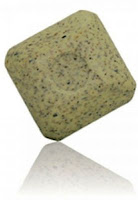.gif) |
| Chlorella(綠球藻),又名小球藻 |
希臘語的Chloros,就是「綠色」的意思,而elle是拉丁語「小」的意思,這兩句結合起來成為Chlorella(綠球藻)。它的細胞大小約只有2-8微米(µm),與人體紅血球體積相似,因此有研究機構稱之為『綠血球』。由於細胞非常微小,無法以肉眼觀察,必須藉由 600倍以上的顯微鏡方可看見,1公克綠藻就是由60億個優質綠藻細胞所製成的,可見其珍貴。綠球藻之體積除了與人類紅血球相同外,它更是含有豐富的葉綠素,和人類之血紅素構造相似,綠球藻對人類具有補血、清理和正常化生理等功能。
在陽光與養份豐富之生長環境下,綠球藻可以在一日之內完成一次以上的細胞分裂,產生四個新細胞 ; 而每一新細胞又有足夠養份和能量獨立生長,生生不息地繼續細胞分裂,具有快速的繁殖能力與旺盛的生命力,因此世界衛生組織曾研究如何大量生產以供應人類食糧需求並稱其為 “二十一世紀最佳食品”。
綠球藻對於人體的功效
- 綠球藻可以正常化免疫系統:
★綠球藻之細胞壁含酸性多醣體可引發人體產生干擾素 (Interferon)。干擾素可明顯地增加體內吞噬細胞,吞掉外來細菌和致病物質,又有抗癌的效果。
★綠球藻內之綠藻成長素 (Chlorella growth factor) 可刺激T細胞,從而提高人體免疫能力 (特別是對抗病毒能力)。
★綠球藻含大量之胡蘿蔔素,亦是正常化免疫系統之重要物質。綠球藻可以使虛弱之抵抗力提高而治癌,防癌,減少病毒感染 (如感冒) 等,亦可以平衡過於亢進之自身免疫系統而使之趨向正常 。 - 綠球藻可以調節酸鹼體質:現代人食用過多之肉類造成血液偏向酸性和黏稠度增加,而影響血液循環與養份的供應,產生組織器官功能衰退、疲勞、抵抗力減弱等毛病,綠球藻因為是鹼性食品,故能中和酸性體質而起著調節酸鹼體質作用
- 綠球藻比牛肝含更高的維他命B12,在人類飲食中,維他命B12的主要來源是動物性食物,在植物中(除極少數外)都不含B12,所以綠藻素對素食者是非常重要的,它能促使注意力集中,增進記憶力、平衡感。
- 綠球藻比菠菜多6倍的胡蘿蔔素,有抗癌作用,有助降低有害的膽固醇含量,以及減少心臟病的發生,並有助去除老人斑。同時葉綠素具有人體所缺乏的解毒酵素的單線氧自由基,其和維生素E相比,其活性為維生素E的一百倍
- 支援肌膚增生支撐結構的蛋白(Skin restructuring):綠藻富含核酸(DNA, RNA)與蛋白質(約60%),可以改善皮膚支持結構。最新研究發現其可以幫助人體之基因修補,治療和補充之作用,亦即可以使細胞保持健康之新陳代謝作用,而有保健與養顏 (抗衰老) 作用。
- 改善膚色:綠球藻能提供比螺旋藻多12倍的鐵質,鐵質對紅血球組成非常重要,紅血球負責輸送氧氣及營養給身體各部份,從而使身體保持健康,精力充沛,同時鐵質可防止疲勞、貧血,並可恢復血色良好的皮膚。
- 天然食用色素:綠藻中富含葉綠素(約3%)可以做成綠藻色素供食用或作為化妝品色素用,強烈建議「花精」、「靈性彩油」的產品改用天然色素。
- 幫助保溼:具有多醣體(polysaccharide)。
- 補充細胞能量:完整的人體基本胺基酸(essential amino acid)、維他命B群提供肌膚細胞充分的能量。
- 眼部護理:綠藻含有豐富氨基酸以及寡多肽,結合海藻多酚類具抗氧化及抗炎作用,讓綠藻可以透過強化微細血管功能(antivascular imperfections)來改善眼部浮腫與黑眼圈(dark circles)。

左圖:使用前 右圖:使用四周後(圖片來源) - 除口臭:綠球藻比一般綠色食品高出10倍的葉綠素,葉綠素是一種天然的殺菌者,能能消炎、解毒、通便秘、剌激大腸蠕動,將廢物排出體外,淨化血液,提高豐富氧氣,增加活力,並促進新陳代謝(Bajgus et al., 1998)。
- 塑身:海藻碘,可以提高基礎代謝率(BMR)。
- 排毒:綠球藻的細胞壁的結構(外層主要由纖維素、果膠質、藻酸銨岩藻多糖和聚半乳糖硫酸酯等多層微纖絲組成的多孔結構, 內層主要成分是纖維素)以及細胞外壁還富含藻細胞釋放的以多肽、多糖( 藻酸鹽、鹽藻衣聚糖等) 為主的胞外產物。這些多聚複合體給藻類提供了大量可以與金屬離子結合的官能團( 如羧基、氨基、醛基、羥基、巰基、磷酰基及羰基等) (Jorge L, Garden T, Dennis W, et al., 1990),而且細胞壁表面多褶皺, 可供吸附表面積很大,這些特點讓綠藻具有很強的重金屬吸收能力,可以明顯地把人體積聚之毒素排出體外,把日常生活中不知不覺地吃進的食物污染物如農藥、P.C.B(多氯聯苯)、水銀、鎘、鋁、鉛、砷等致癌或致病物質排出。
圖片與參考資料來源(References):
- 海洋大學養殖研究所[沈曉瑄]之綠球藻網頁
- 圖片及部分資料來源:台灣綠藻工業股份有限公司網頁
- Bajgus, A., Czerpak, R., 1998. Physiological and biochemical role of brassinosteroids and their structure activity relationship in the green alga Chlorella vulgaris Beijerinck (Chlorophyceae). Journal of plant growth regulation. vol. 17 (3) p. 131-139.
- Chen, Y.C., 2001. Immobilized microalga Scenedesmus quadricauda (Chlorephyta, Chlorococcales) for long-term storage and for application for water quality control in fish culture. Aqua. 195, 71-80.
- Chen, Y.C.,2003. Immobilized Isochrysis galbana (Haptophyta) for long-term storage and applications for feed and water quality control in clam (Meretrix lusoria) cultures. J. Appl. Phycol.
- Chevalier, P., de la Noüe, J., 1985. Wastewater nutrient removal with microalgae immobilized in carrageenan. Enzyme Microb. Techol. 7:621-624.
- Faafeng, B.A., von Donk, E., Kallqvist, S.T., 1994. In situ measurement of algal growth potential in aquatic ecosystems by immobilized algae. J. Appl. Phycol. 6:301-308.
- González, L.E., Cañizares, R.O., Baena, S., 1997. Efficiency of ammonia and phosphorus removal from Colombian agroindustrial wastewater by the microalgae Chlorella vulgaris and Scenedesmus dimorphus. Bioresoure. Technol. 60, 259-262.
- Gonzalez-Bashan, L.E., Lebsky, V.K., Hernandez, J.P., Bustillos, J.J.,
- Bashan, Y., 2000. Changes in the metabolism of the microalga Chlorella vulgaris when coimmobilized in alginate with the nitrogen-fixing Phyllobacterium myrsinacearum. Can. J. Microbial.
- /Rev. Can. Microbial. vol. 46, no. 7, pp. 653-659.
- Gonzalez, L.E., Bashan, Y., 2000. Increased growth of the microalga Chlorella vulgaris when coimmobilized and cocultured in alginate beads with the plant-growth-promoting bacterium Azospirillum brasilense. Appl. Environ. Microbiol. no. 4, pp. 1527-1531.
- Han, Y.H., Lee, J.S., Kwak, J.K., Cho, M.G., Lee, E.H., 1999. High-density cultivation of microalgae using microencapsulation. J. Korean Fish. Soc. vol. 32, no. 2, pp. 186-191.
- Hernandez, M., Travieso, L., Rojas, J.,2000. Effect of microalgae (Scenedesmus obliquus) immobilization in different matrices on nutrient capture. Bol. Cent. Invest. Biol. (Maracaibo). vol. 34, no. 2, pp. 81-91.
- Hoek, C., van den., Mann, D.G., Jahns, H.M., 1995. Algae. Cambridge University Press.
- Jeafils, J., Canisius, M-F., Burlion, N., 1993. Effect of high nitrate concentrations on growth and nitrate uptake by free-living and immobilized Chlorella vulgaris cells. J. Appl. Phycol. 5, 369-374.
- Kaya, V.M., De la Nouee, J., Picard, G., 1994. A comparative study of four systems for tertiary wastewater treatment by Scenedesmus bicellularis: New technology for immobilization. J. Appl. Phycol. vol. 7, no. 1-2.
- Kaya, V.M., Picard, G., 1995. The viability of Scenedesmus bicellularis cells immobilized on alginate screens following nutrient starvation in air at 100% relative humidity. Biotechnol. Bioeng. vol. 46, no. 5, pp.
- 459-464.
- Koo, J., Bai, S.C., Kim, K., Kim, S., 2001. Optimum dietary level of Chlorella powder as a feed additive for growth performance of juvenile olive flounder, Paralichthys olivaceus. J. Appl. Aquaculture. Vol. 11 (1/2) p. 55-66
- Laliberté, G., de la Noüe, J., 1993. Auto-, hetero-, and mixotrophic growth of Chlamydomonas humicola (Chlorophyceae) on acetate. J. Phycol. 29, 612-620.
- Lau, P.S., Tam, N.F.Y., Wong, Y.S., 1995. Effect of algal density on nutrient removal from primary settled wastewater. Environ. Pollut. 89, 59-66.Lau, P.S., Tam, N.F.Y., Wong, Y.S., 1996. Wastewater nutrients removal by Chlorella vulgaris:Optimization through acclimation. Environ. Technol. 17, 183-189.
- Lau, P.S., Tam, N.F.Y., Wong, Y.S., 1998. Effect of carrageenan immobilization on the physiological activities of Chlorella vulgaris. Bioresoures. Technol. 63, 115-121.
- Maleriat, J.P.,Jaouen, P
- ., Rossignol, N., Schlumpf, J-P., Quemeneur, F., 2000. Influence of alginates adsorption on properties of ultrafiltration and microfiltration organic membranes. Rev. Sci. Eau/J. Water Sci. Vol. 13, no. 3, pp. 269-287.
- Mayo, A.W., Noike, T., 1994. Effect of glucose loading on the growth behavior of Chlirella vulgaris and heterotrophic bacteria in mixed culture. Wat. Res. 28(5), 1001-1008.
- Merchant, R.E., Ander, C.A., Sica, D.A., 2002. Nutritional supplementation with Chlorella pyrenoidosa for mild to moderate hypertension. J. Medic. Food. vol. 5(3)p. 141-152.
- Tam, N.F.Y., Wong, Y.S., 1996. Effect of ammonia concentrations on growth of Chlorella vulgaris and nitrogen removal from media. Bioresoure. Technol. 57, 45-50.
- Tam, N.F.Y., 2000. Effect of immobilized microalgae bead concentrations on wastewater nutrient removal. Environ. Pollu. vol. 107 (1) p. 145-151
- Travieso, L., Benitez, F., Weiland, P., Sánchez, E., Dupeyrón, R., Dominguez, A.R., 1994. Experiments on immobilization of microalgae for nutrient removal in wastewater treatments. Bioresoure. Technol. 55, 181-186.
- Wilkinson, S.C., Goulding, K.H., Robinson, P.K., 1990 a. Immobilized algae for wastewater treatment. Br. Phycol. J., vol. 25, no. 1, p. 99.
- Wilkinson, S.C., Goulding, K.H., Robinson, P.K., 1990 b. Mercury removal by immobilized algae in batch culture systems. J. Appl. Phycol. 2:223-230.
- Wong, Y.S., Tam, N.F.Y., Wastewater treatment with algae / Yuk Shan Wong, Nora F.Y. Tam (eds.). Environmental intelligence unit 234 p. : ill. ; 24 cm.





.jpg)








.jpg)





.jpeg)








.jpeg)
.jpeg)



.jpeg)





.jpeg)


.jpeg)


.jpeg)
